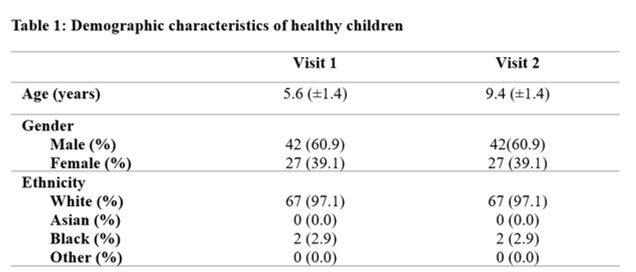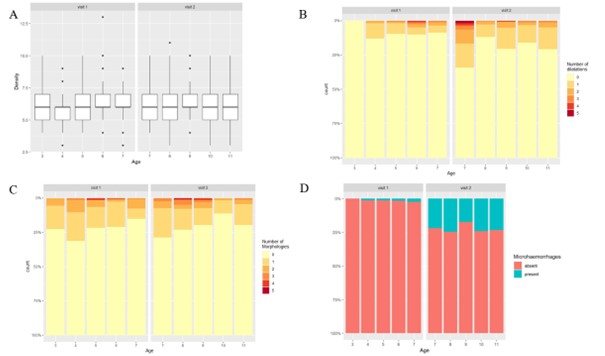Session Information
Session Type: Poster Session A
Session Time: 10:30AM-12:30PM
Background/Purpose: Capillaroscopy is a well-established tool in the diagnosis of adult-onset rheumatic diseases and global consensus on standardisation of execution and interpretation performing capillaroscopy have been published. Recently, the first multicentre cross-sectional study evaluated capillaroscopic findings in children with rheumatic diseases and healthy controls. However, there have been no longitudinal studies.
Methods: Sixty-nine healthy schoolchildren underwent two capillaroscopies with a mean interval of 3.8 years. A standardized NVC technique with a 200x magnification lens was used on all fingers, except for the thumbs. Two images were captured per nailfold on which a 1mm grid was placed. The quantitative and qualitative analysis of capillaroscopic images was performed according to the EULAR Study Group on Microcirculation in Rheumatic Diseases consensus1. Descriptive statistics were performed. Different generalized linear mixed models (GLMMs) were used to model the mean density, mean apical diameter, mean number of dilatations and abnormal shapes, and the probability of microhaemorrhages. A Bonferroni correction for multiplicity by setting the confidence level to 99.5% was executed.
Results: Demographics are shown in Table 1. A statistical significant difference was observed for capillary density between visit 1 and 2 according to age with a stronger increase in density for younger ages (p = 0.004). However, the mean difference remained small (< 1 capillary/linear mm), showing no clinical difference (Figure 1A). There was no statistical significant difference in density between genders (p = 0.368) nor in the mean number of dilatations and abnormal shapes between visit 1 and 2 (p = 0.615; p = 0.811) (Figure 1B-C). A statistical significant difference in presence of haemorrhages between visits was found (p< 0.001), adjusted for trauma (p=0.680) (Figure 1D).
At visit 1 none of the healthy children had a scleroderma pattern, 13% a stereotype normal and 87% non-specific changes. At visit 2, 1 child had a scleroderma pattern, 10.1% a stereotype normal and 88.4% non-specific changes.
Conclusion: This study suggests that there is no clinically significant difference in capillaroscopic findings over time in healthy children without Raynaud’s phenomenon. There seems to be a higher prevalence of non-specific patterns compared to healthy adults. Also in healthy children, a scleroderma pattern is rare. A large multicentre study through EULAR is being executed to validate these results.
To cite this abstract in AMA style:
Dufour T, Cutolo M, Schonenberg-Meinema D, Wyckstandt K, Sarbu A, dehoorne j, Wallaert S, smith v. Prospective Evaluation of Capillaroscopy in Healthy Children [abstract]. Arthritis Rheumatol. 2024; 76 (suppl 9). https://acrabstracts.org/abstract/prospective-evaluation-of-capillaroscopy-in-healthy-children/. Accessed .« Back to ACR Convergence 2024
ACR Meeting Abstracts - https://acrabstracts.org/abstract/prospective-evaluation-of-capillaroscopy-in-healthy-children/


